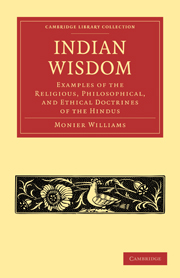Book contents
- Frontmatter
- PREFACE
- THE INDO-ROMANIC ALPHABET WITH THE EQUIVALENT SANSKṚIT LETTERS AND RULES FOR PRONUNCIATION
- Contents
- INTRODUCTION
- LECTURE I The Hymns of the Veda
- LECTURE II The Brāhmana Portion of the Veda
- LECTURE III The Systems of Philosophy
- LECTURE IV The Nyāya System of Philosophy
- LECTURE V The Sānkhya System of Philosophy
- LECTURE VI The Mimāṉsā System of Philosophy
- LECTURE VII Irregular Systems and Eclectic School
- LECTURE VIII Smṛiti. The Vedāngas
- LECTURE IX Smārta-sūtra. Gṛihya, ‘domestic rules’
- LECTURE X The Law-books. Mainu continued
- LECTURE XI Metrical Version of some of Manu's Moral and Religious Precepts
- LECTURE XII The Epic Poems
- LECTURE XIII The Mahā-bhārata
- LECTURE XIV The Epic Poems compared together and with Homer
- LECTURE XV The Artificial Poems
- INDEX
- ADDITIONS AND CORRECTIONS
- ORIENTAL WORKS
LECTURE III - The Systems of Philosophy
Published online by Cambridge University Press: 29 August 2010
- Frontmatter
- PREFACE
- THE INDO-ROMANIC ALPHABET WITH THE EQUIVALENT SANSKṚIT LETTERS AND RULES FOR PRONUNCIATION
- Contents
- INTRODUCTION
- LECTURE I The Hymns of the Veda
- LECTURE II The Brāhmana Portion of the Veda
- LECTURE III The Systems of Philosophy
- LECTURE IV The Nyāya System of Philosophy
- LECTURE V The Sānkhya System of Philosophy
- LECTURE VI The Mimāṉsā System of Philosophy
- LECTURE VII Irregular Systems and Eclectic School
- LECTURE VIII Smṛiti. The Vedāngas
- LECTURE IX Smārta-sūtra. Gṛihya, ‘domestic rules’
- LECTURE X The Law-books. Mainu continued
- LECTURE XI Metrical Version of some of Manu's Moral and Religious Precepts
- LECTURE XII The Epic Poems
- LECTURE XIII The Mahā-bhārata
- LECTURE XIV The Epic Poems compared together and with Homer
- LECTURE XV The Artificial Poems
- INDEX
- ADDITIONS AND CORRECTIONS
- ORIENTAL WORKS
Summary
I MUST now advert in a general way to the six systems of philosophy which grew out of the Upanishads. They are sometimes called the six Śāstras or bodies of teaching, sometimes the Shaḍ Darśanas or six Demonstrations. They are—
The Nyāya, founded by Gotama.
The Vaiśeshika, by Kanāda.
The Sānkhya, by Kapila.
The Yoga, by Pataṅjali.
The Mīmāṉsā, by Jaimini.
The Vedānta, by Bādarāyaṇa or Vyāsa.
They are delivered in Sūtras or aphorisms, which are held to be the basis of all subsequent teaching under each head.
It is as impossible however to settle the date of any of them with certainty as it is to determine the period of the composition of any single work in Sanskṛit literature. Moreover, it is scarcely practicable to decide as to which of the six systems of philosophy preceded the other in point of time. All we can say is, that about 500 years before the commencement of the Christian era a great stir seems to have taken place in Indo-Āryan, as in Grecian minds, and indeed in thinking minds everywhere throughout the then civilized world. Thus when Buddha arose in India, Greece had her thinker in Pythagoras, Persia in Zoroaster, and China in Confucius. Men began to ask themselves earnestly such questions as—What am I? whence have I come? whither am I going? How can I explain my consciousness of personal existence? What is the relationship between my material and immaterial nature? What is this world in which I find myself? Did a wise, good, and all-powerful Being create it out of nothing?
- Type
- Chapter
- Information
- Indian WisdomExamples of the Religious, Philosophical, and Ethical Doctrines of the Hindus, pp. 48 - 70Publisher: Cambridge University PressPrint publication year: 2010First published in: 1875

